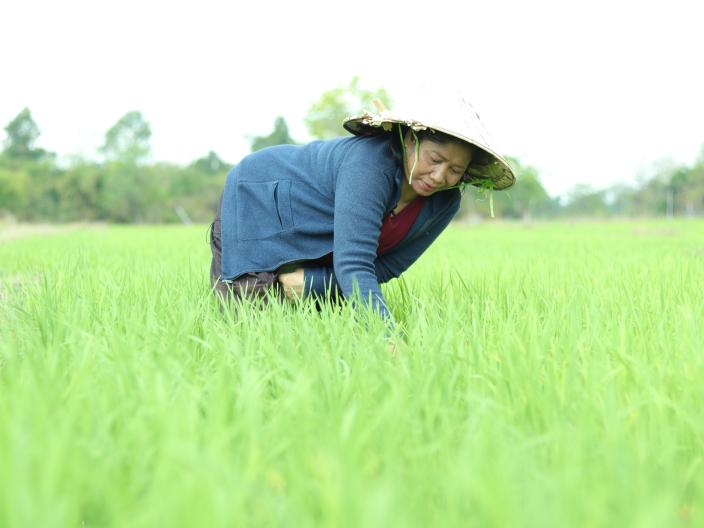“Coordinating joint activities to support the livelihoods of each family, clarifying misunderstandings among group members, and maintaining harmony because, without it, we would not be able to work.”
Kaisone shoulders several responsibilities as the leader of the Lao Women Union and the Clean Agriculture Group in Don Sahong Village. She acknowledges that mobilizing the women of Don Sahong and surrounding villages towards sustainable livelihoods development comes with its set of challenges. However, with the nearby river, a life source for the natural ecosystem and village communities, depleted, the stakes are high. Since the start of the Don Sahong Dam operation in 2016, water used for drinking and general purposes has all but run out. Kaisone, like many others in the village, made a living from rice cultivation and fishing in the Mekong River. Switching from fishing to farming vegetables was a coping mechanism for most families—often only growing enough for consumption. For Kaisone, the lack of finances to support the family meant her children had to move to neighboring countries to earn supplemental income.
“We fished for a living, meaning we relied on the Mekong River. We cannot do that now as there is no place to fish.” The hydropower dam has brought some positive changes to the community. Villagers now have access to better roads, electricity, irrigation infrastructure, and a development fund based on annual loans. Nevertheless, without a consistent supply of water, struggles continue. “Fortunately, Oxfam’s project to promote duck raising and vegetable plantation went well. The project researched different themes to determine the issues and impacts our people faced. The insights informed us that our income from fishing had reduced compared to the past. Initially, we developed a proposal to seek assistance from the Don Sahong Dam operation team but received none. Eventually, the project supported our people, technically and financially, to set up alternative livelihood sources. It was the best solution for my village, so I decided to participate in the project immediately.”
Kaisone frequently engages with local authorities and the Dam operations team to advocate for the needs of her community. “I believed the women in my community are very capable in finding solutions to the issues that the community experiences, sometimes more so than the men,” recalling Kaisone’s words form a previous interview. A few years ago, she lobbied with district authorities to address illegal fishing, using electrical-shock equipment. The district authorities acted swiftly to support on the matter. Recently, she and the group pushed the Dam operations team to drill more water boreholes. Whether the Don Sahong operations team will act is yet unclear, so in the meantime, Kaisone is doing what she can to ensure that families can sustain themselves.
“The members have confidence in me to lead the group on activities that can generate stable income. In the past, I proved that I could find the right market for our products and coordinate activities with community members, so they elected me as the leader. I believe I brought positive changes as a leader. Since 2018, the group revenue increased to more than 200 million KIP (USD 17,240) from selling ducks, a livelihood activity to replace fishing."Kaisone's success in raising ducks and growing organic vegetables earned her praise and a certification from the district authorities as a model farmer, allowing Kaisone to engage the women of Don Sahong with newfound confidence and a sense of purpose. "When engaging other women to participate in the activities, it is good to raise tangible examples. It is necessary to explain the process and importance of each activity run by the group and illustrate the benefits. For instance, how much they would earn from raising one hundred ducks and who will buy from them. As for planting vegetables, like ‘xay,’ we tell them how long it takes to grow the plant, how they can sell it, and how much profit they would get. When potential members understand better, they volunteer to collaborate with us. We do it so our lives can improve."
In 2020, the pandemic reigned in, disrupting project activities, and preventing the Don Sahong community from selling their products. "During this period, the issue we faced was lack of market access to sell our products. We had to innovate to overcome these challenges. For instance, we processed the ducks using wax ourselves and sold them within the villages as other provinces were inaccessible. We also experienced issues with our xay harvest, as the Lao Covid-19 task force prohibited all transportation to Vientiane Capital. Thus, we had to dry and store them. More than anything, what helped us overcome these issues was our persistence and the harmony within the group. A key factor that helped was our frequent group discussions and consultations."
Kaisone wants to see more women leaders in her community advocate and act on natural resource protection and sustainable livelihoods development and intends to open more opportunities for her community. “I have to be a good role model for other women to see and be inspired. Several women have joined us, particularly in planting xay. We must maintain the activities, whether raising ducks or planting xay. Soon, our group will begin planting rice and supplying it to Phougneun Company which has offered us a guaranteed minimum price. In addition to benefiting the group, the company will open a market for all villagers.”
